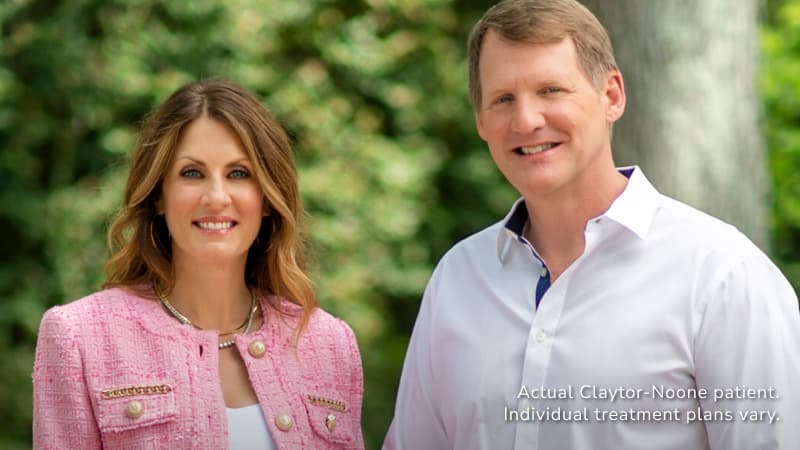Eyelid Surgery (Blepharoplasty)
Drooping upper eyelids and puffiness below the eyes can age your appearance and cause you to look tired and uninterested, even when you feel refreshed and energetic. Excess skin in this area can even affect your field of vision. To address the excess skin above the upper eyelid and transform your entire appearance, board certified plastic surgeon Dr. Brannon Claytor offers eyelid lift, also known as blepharoplasty, to patients in the Philadelphia and surrounding areas.
What is eyelid lift, or blepharoplasty?
Eyelid lift surgery—also called an eye lift or blepharoplasty—removes excess fat, skin, and muscle from the upper (and lower, as needed) eyelids to rejuvenate puffy, sagging or tired-looking eyes. Eyelid lift is typically performed for cosmetic reasons, but can also be used to improve vision by correcting upper eyelid ptosis (droopy eyelids) out of the patient’s field of vision.
Blepharoplasty surgery does not raise the heavy, sagging eyebrows or reduce the appearance of wrinkles, crow’s feet, or dark circles under the eyes. To lift a heavy brow, a brow lift is needed. To rejuvenate the wrinkles of the midface and neck, procedures such as a facelift or injectable Botox® or dermal fillers may be needed. If you are a good candidate for combined surgeries, Dr. Claytor may be able to perform blepharoplasty during another procedure so that you can have one consolidated recovery period and more complete rejuvenation of the face.
Dr. R. Brannon Claytor
Dr. Claytor is board certified by the American Board of Plastic Surgery and holds over 20 years of experience as a cosmetic plastic surgeon. An innovator and teacher in the field of plastic surgery, he uses advanced techniques like the drain-free tummy tuck and deep plane facelift to streamline recovery and provide natural-looking, durable results.
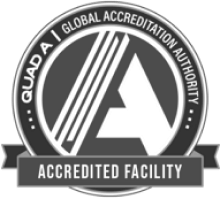
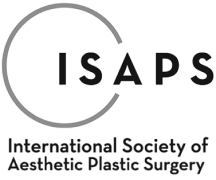
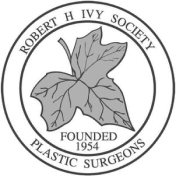

What are the benefits of having eyelid surgery?
By removing excess fat, skin and muscle from the upper and lower eyelids, blepharoplasty has many benefits including:
- Rejuvenating puffy, sagging or tired-looking eyes
- Improved vision by lifting droopy eyelids out of the patient’s field of vision
I’m unhappy with the appearance of my upper face, am I a good candidate for blepharoplasty?
A good candidate for blepharoplasty typically has one or more of these facial concerns:
- Excess skin on the upper eyelids (upper eyelid surgery)
- Bags or puffiness under the eyes (lower blepharoplasty)
- Droopy lower eyelids that reveal the white below the iris (lower blepharoplasty)
- Wrinkles and fine lines around the eyes that make you look older or tired (lower blepharoplasty + upper eyelid surgery)
During your facial surgery consultation, Dr. Claytor will evaluate your skin and and discuss your facial concerns and may recommend upper blepharoplasty for excess skin removal, lower blepharoplasty for excess orbital fat and skin removal, or both to improve the appearance of your upper face. Some Philadelphia facial plastic surgery patients also benefit from a brow lift, as a heavy brow often contributes to excess eyelid skin on the upper eyelid.
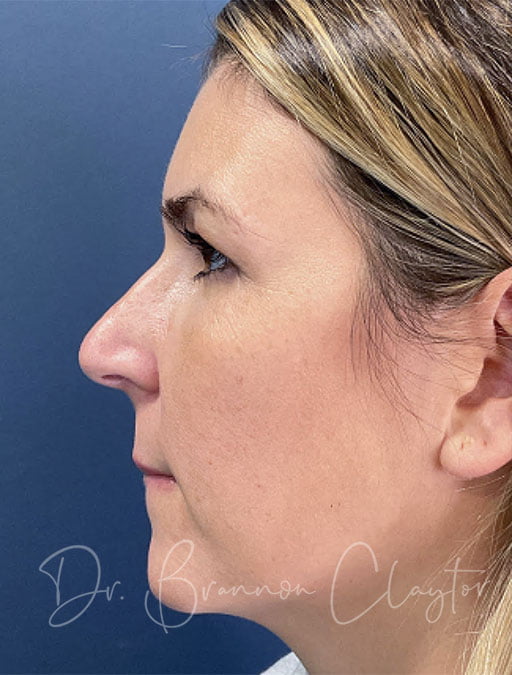
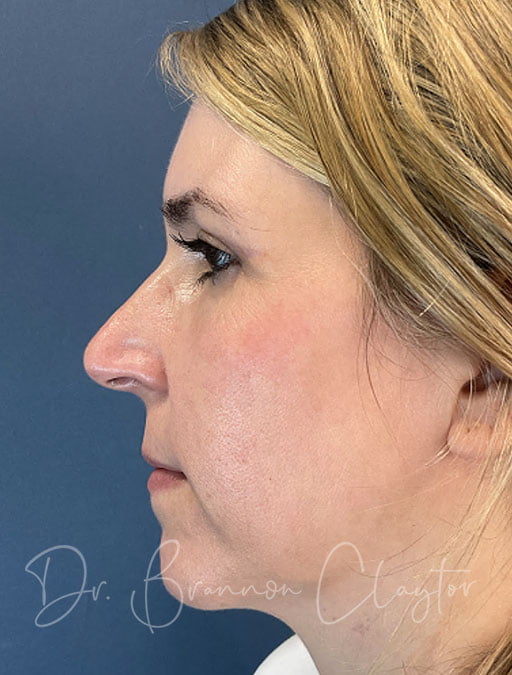
*Individual results may vary.
How is blepharoplasty performed, and how long does it take?
Dr. Claytor performs most facial plastic surgery procedures in our office under local anesthesia, which allows you to recover more quickly and comfortably without the lasting side effects of general anesthesia. Blepharoplasty incisions are made along the eyelids in inconspicuous places: in the creases of the upper lids, and just below the lashes on the lower lids. Through these incisions, Dr. Claytor removes excess tissue—usually fat, skin, and a small amount of muscle, and then stitches them closed with fine sutures. He will apply an ointment to the closed sutures. In the case that no skin needs to be removed, Dr. Claytor will likely perform a transconjunctival blepharoplasty technique, in which the incision is made inside the lower eyelid and there are no visible scars. The procedure time can vary, lasting about 45 minutes up to a few hours depending on how much work is required to achieve your goals for your eyes.
What is recovery like after eyelid surgery?
After facial surgery, a trusted adult should drive you home. For the first two weeks after facial plastic surgery, you will not be able to wear contact lenses. We will advise you to apply ice packs to the area, and to keep your head elevated to reduce swelling. Pain will be managed with medication. Eyes can be sensitive to light and wind, and you may experience irritation for a short while. Dr. Claytor may prescribe eye drops and cool compresses to counteract these discomforts. Dr. Claytor will remove the stitches 4 to 7 days after surgery, and you should be able to return to work in 10 days. Most people need to wait 2 weeks before applying makeup, and about 4 weeks before resuming full activity levels. Dr. Claytor and our facial plastic surgery team will guide you through recovery during your post-operative appointments, and will offer you personalized recommendations to alleviate your concerns and ensure that you are not doing too much, too fast.
- Key Benefits
- Glossary
- Rejuvenating puffy, sagging, or tired-looking eyes: Eyelid surgery, also known as blepharoplasty, can help restore a youthful appearance by removing excess skin and fat from the eyelids.
- Minimal scarring: Surgeons use discreet incisions along natural eyelid creases, resulting in inconspicuous scars that are easily concealed.
- Improved vision: By lifting droopy eyelids out of the patient’s field of vision, eyelid surgery may enhance visual clarity and peripheral sight.
- Reduction of eye discomfort: This procedure can alleviate discomfort caused by heavy, drooping eyelids, reducing strain and fatigue.
- Complementary to other facial procedures: Eyelid surgery can be combined with other facial surgeries to achieve comprehensive facial rejuvenation.
- Minimal downtime: Recovery is relatively quick, with most patients returning to normal activities within a week or two.
Blepharoplasty: The clinical term for an eyelid lift surgery, which can be performed on the upper or lower eyelids to remove excess skin and fat.
Upper Blepharoplasty: Upper blepharoplasty, often referred to as upper eyelid surgery, is a cosmetic procedure designed to rejuvenate the appearance of the upper eyelids. This procedure aims to address sagging, drooping, and excess skin that often occurs with aging, or is sometimes due to genetics. During upper blepharoplasty, the surgeon makes an incision along the natural crease of the upper eyelid, removes excess skin, and may reposition or remove fat deposits, as well as tighten the muscles, if necessary. The result is a more alert and refreshed appearance, with a reduction in the “hooded” look that can occur with age.
Lower Blepharoplasty: Lower blepharoplasty is a surgical procedure targeting the lower eyelids. It is primarily used to correct bags under the eyes, remove excess skin and wrinkles, and provide a more youthful and rested appearance. The surgeon may choose different techniques depending on the patient’s anatomy and desired outcomes, such as transconjunctival blepharoplasty (incision made inside the eyelid) or subciliary approach (incision made just below the lashes). Fat may be removed or repositioned to address puffiness and hollow areas, and the skin may be tightened to improve tone.
Ptosis: Refers to drooping or falling of the upper or lower eyelid.
Transconjunctival Blepharoplasty: A type of eyelid surgery where the incision is made inside the lower eyelid, leaving no visible scar.
Oculoplastic Surgeon: A surgeon specializing in plastic and reconstructive surgery of the periorbital and facial tissues.
Crease Formation Surgery (or Double Eyelid Surgery): A procedure to create or enhance the upper eyelid crease, popular among individuals of Asian descent.
Browpexy: A procedure to elevate the eyebrow, which can also affect the appearance of the eyelids.
Brow Lift (or Forehead Lift): A procedure often done in conjunction with blepharoplasty to raise the eyebrows and reduce the appearance of drooping or sagging eyelids.
Lacrimal Gland: The gland that produces tears, sometimes involved or affected in eyelid surgery.
Levator Muscle: The muscle responsible for lifting the upper eyelid.
Will I have a scar after eyelid surgery?
Dr. Claytor will educated you about best practices to take care of your healing incisions and manage your scar once incisions have closed. Facial plastic surgery scars improve in appearance dramatically after 1 year, and they continue to fade with proper care even after that. Generally, be sure to protect your scar from the sun. We will discuss any options you have for diminishing any visible scars after they have fully mature; this could include microneedling or laser treatments.
Are there risks to getting blepharoplasty?
Complications from an eye lift are uncommon, but any facial plastic surgery procedure carries certain risks. It’s extremely important that if you have thyroid problems, dry eye, high blood pressure, diabetes, detached retina, glaucoma or other health problems, you consult with an ophthalmologist about whether or not your condition allows you to safely undergo blepharoplasty. Dr. Claytor will carefully screen you during your consultation to make sure you are good candidate for eyelid lift or any other facial rejuvenation procedure you seek.
Potential complications after blepharoplasty may include:
- Infection
- Reaction to anesthesia
- Double or blurry vision for a few days
- Temporary swelling of the eyelids
- Tiny whiteheads
- Difficulty closing eyes when going to sleep
Uneven healing and facial scarring, and ectropion (pulling down of the lower lids) are very rare and may require cosmetic surgery to correct.
“Dr. Claytor and the entire staff are absolute rockstars! I am just 12 days post upper blepharoplasty (eyelid lift), and I am amazed and thrilled, and the final results haven’t even revealed themselves yet. From consultation to completion, it has been an absolute dream. They truly care about what they do, they care about you and your goals, you will never feel rushed or like you don’t matter, they treat you like a person of value – something that unfortunately is rare these days. I appreciated every phone call when they called to check on me, and special shout out to Debbie who was wonderful when I had to postpone due to a personal issue. A million thank yous to Dr. Claytor, Julie, Debbie, Dani, the nurses, med students, everyone who calls that office home. You are appreciated.”
Why choose Dr. Claytor for your plastic surgeon?
Double Board-Certified for a high level of safety and precision
Chief of Plastic Surgery at Main Line Health, a top health system
Board Member of The Aesthetic Society, shaping the future of aesthetics
8x Philadelphia Magazine Top Doctor for exceptional patient care
Recognized as one of America’s Best Plastic Surgeons by Newsweek
Drain-free recovery expert for faster, more comfortable healing
Deep plane facelift innovator and global educator
Active researcher in surgical and non-surgical aesthetic advancements
Highly regarded for his surgical expertise and outcomes, as well as his dedicated follow-up care





Philadelphia board-certified plastic surgeon Dr. R. Brannon Claytor has over 20 years of experience offering cosmetic plastic surgery procedures, and at Claytor Noone Plastic Surgery, he is here to serve patients from Philadelphia, Main Line, and surrounding areas. A member of The Aesthetic Society’s Board of Trustees, the American Society of Plastic Surgeons (ASPS), and a Fellow of the American College of Surgeons (FACS), Dr. Claytor is dedicated to continuously advancing his surgical techniques and teaching his methods to colleagues at national meetings. In addition to his surgical work, Dr. Claytor the Chief of Plastic Surgery for Main Line Health Systems, and is a Clinical Associate Professor at Lankenau Institute of Medical Research.
To learn if you are a good candidate for eyelid surgery or other facial rejuvenation options, call (610) 527-4833 or schedule a consultation online with Dr. Claytor
References »
Will MJ. Upper Eyelid Blepharoplasty. Atlas of the Oral and Maxillofacial Surgery Clinics of North America. 2016 Sep;24(2):125-33. doi: 10.1016/j.cxom.2016.05.008.
Olds C, Most SP. Upper Blepharoplasty. JAMA. 2019;321(13):1320. doi:10.1001/jama.2019.1957
Branham GH. Lower Eyelid Blepharoplasty. Facial Plastic Surgery Clinics of North America. 2016 May;24(2):129-38. doi: 10.1016/j.fsc.2015.12.004.
Finsterer J. Ptosis: causes, presentation, and management. Aesthetic Plastic Surgery. 2003 May-Jun;27(3):193-204. doi: 10.1007/s00266-003-0127-5.
Areas Served:

Medically reviewed by Dr. R. Brannon Claytor — Updated on Oct 26, 2024

